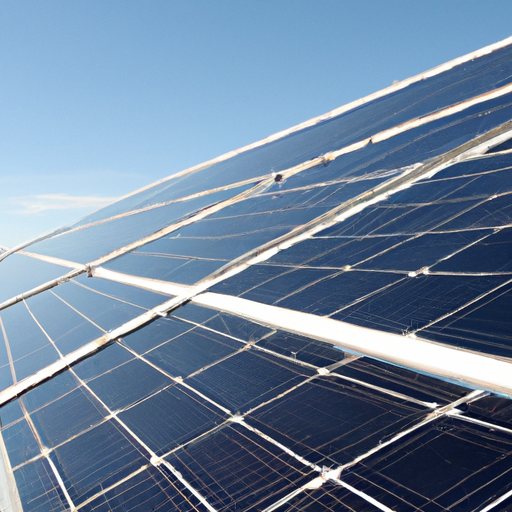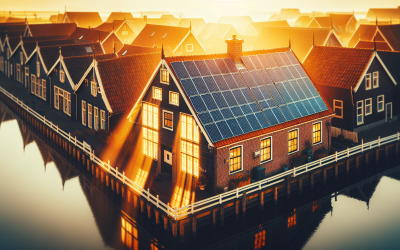So, you’ve been considering going solar, but you’re not quite sure about the cost. Well, luckily for you, we’ve got all the answers you need. In this article, we’ll break down the cost of a solar panel system, giving you a better understanding of what to expect and helping you make an informed decision. From installation to maintenance, we’ll cover it all. So, let’s get right into it, shall we?
Factors Affecting Solar Panel System Cost
When it comes to the cost of a solar panel system, there are several factors that come into play. Understanding these factors can help you make an informed decision when considering solar energy for your home or business. Here are the main factors that affect the cost of a solar panel system:
Size of the Solar System
One of the primary factors that determine the cost of a solar panel system is its size. The size of the system is usually measured in kilowatts (kW) and refers to the power output of the panels. A larger system will produce more electricity and therefore cost more. The size of the system you need will depend on your energy consumption and the amount of roof or land space available for installation.
Quality and Brand of the Panels
The quality and brand of the solar panels also play a significant role in determining the cost. Higher-quality panels from reputable brands tend to be more expensive. However, they often come with longer warranties and better performance, which can be a worthwhile investment in the long run. It’s important to research and compare different panel brands to find the best balance between cost and quality for your specific needs.
Type of Mounting System
The type of mounting system used for the solar panels can affect the cost as well. There are various options available, including roof-mounted and ground-mounted systems. Roof-mounted systems are typically more affordable since they utilize existing structures. On the other hand, ground-mounted systems require additional materials and labor, making them more expensive.
Installation Complexity
The complexity of the installation process can impact the cost of a solar panel system. Factors such as the condition of the roof, accessibility, and electrical wiring requirements can all affect installation costs. If additional structural modifications or electrical work is needed, the overall cost of the system may increase.
Inverter Efficiency
Inverters are an essential component of a solar panel system, as they convert the direct current (DC) generated by the panels into usable alternating current (AC) electricity. The efficiency of the inverter can affect the overall cost of the system. High-efficiency inverters tend to be more expensive but can result in higher energy generation and better system performance.
Battery Storage
While not always necessary, adding battery storage to a solar panel system can provide backup power during outages or enable energy independence. However, battery storage systems can significantly increase the cost of a solar panel system. The cost of batteries and the additional equipment required for storage should be considered when calculating the overall system cost.
Grid Connection and Net Metering
The cost of connecting the solar panel system to the grid and implementing net metering can also influence the overall cost. Some utility companies charge fees for grid connection, while others may require specific equipment or meters to enable net metering. These costs should be factored into the total expense of the system.
Geographic Location
The geographic location of your property plays a role in the cost of a solar panel system. The availability of sunlight and local weather conditions can affect system performance and efficiency. Additionally, the cost of labor, permits, and materials can vary depending on the region. It’s essential to consider the specific factors of your location when determining the cost of a solar panel system.
Government Incentives and Tax Credits
Government incentives and tax credits can significantly reduce the cost of a solar panel system. Many countries and regions offer financial incentives to promote renewable energy adoption. These incentives can include rebates, grants, tax credits, and low-interest loans. It’s crucial to research and take advantage of all available incentives to minimize the cost of your solar panel system.
Maintenance and Financing Options
The cost of maintaining a solar panel system should also be considered. While solar panels require minimal maintenance, regular cleaning and inspections may be necessary to ensure optimal performance. Some installers offer maintenance packages that include routine check-ups and repairs.
Financing options can also affect the cost of a solar panel system. Purchasing a system outright may require a larger upfront investment, but it provides long-term savings. Alternatively, leasing or power purchase agreements (PPAs) allow you to install a system with little to no upfront cost, but you may have limited ownership benefits.
Average Cost of Solar Panel Systems
To get a better understanding of the cost, let’s take a look at the average costs of solar panel systems for residential, commercial, and utility-scale installations.
Residential Solar Panel System
Residential solar panel systems are designed to power individual homes. The cost of a residential system can vary based on factors such as the size of the system, quality of the panels, and installation complexity.
Commercial Solar Panel System
Commercial solar panel systems are larger installations intended to power businesses and commercial properties. The cost of a commercial system depends on factors like system size, energy needs, and any additional customization required.
Utility-Scale Solar Panel System
Utility-scale solar panel systems are massive installations that generate electricity on a utility-scale level. The cost of these systems can be challenging to estimate as they involve large-scale construction, transmission infrastructure, and complex interconnection processes.
Residential Solar Panel System Costs
Residential solar panel systems come in various sizes, and each size has a different associated cost. Here’s a breakdown of the costs for small, medium, and large residential systems:
Small Residential Systems
Small residential systems typically range from 3 kW to 5 kW and are suitable for powering small households with relatively low energy consumption. The cost of a small residential system can vary from $7,000 to $15,000, depending on the factors mentioned earlier.
Medium Residential Systems
Medium residential systems usually have a capacity of 5 kW to 10 kW and are suitable for average-sized households with moderate energy consumption. The cost of a medium residential system can range from $15,000 to $30,000, depending on various factors.
Large Residential Systems
Large residential systems generally range from 10 kW to 15 kW and are designed for larger homes or households with high energy needs. The cost of a large residential system can vary from $30,000 to $45,000, depending on the specific requirements and installation complexities.
Commercial Solar Panel System Costs
Similar to residential systems, commercial solar panel systems come in different sizes. The cost of a commercial system will depend on its size, energy needs, and customization requirements. Here’s a breakdown of the costs for small, medium, and large commercial systems:
Small Commercial Systems
Small commercial systems typically range from 10 kW to 50 kW and are suitable for small businesses, retail stores, or office buildings with moderate energy consumption. The cost of a small commercial system can vary from $20,000 to $150,000, depending on the factors mentioned earlier.
Medium Commercial Systems
Medium commercial systems usually have a capacity of 50 kW to 100 kW and are designed for larger businesses or facilities with higher energy needs. The cost of a medium commercial system can range from $100,000 to $300,000, depending on various factors.
Large Commercial Systems
Large commercial systems generally range from 100 kW to 1 MW or even larger and are intended to power extensive industrial facilities or large-scale commercial properties. The cost of a large commercial system can vary significantly, ranging from $300,000 to several million dollars, depending on specific requirements and installation complexities.
Utility-Scale Solar Panel System Costs
Utility-scale solar panel systems are the largest installations, supplying electricity to the grid on a massive scale. The cost of a utility-scale system is influenced by several factors, including construction and installation, operating and maintenance, and transmission and interconnection.
Construction and Installation Costs
The construction and installation costs of a utility-scale solar panel system are generally high due to the large size and complexity of the project. These costs typically include site preparation, infrastructure development, panel installation, and related labor expenses. It’s challenging to estimate the exact cost range for utility-scale systems, as they can vary greatly depending on the project’s scope and location.
Operating and Maintenance Costs
Once a utility-scale solar panel system is operational, there are ongoing operating and maintenance costs to consider. These costs include monitoring the system’s performance, periodic inspections, and any necessary repairs or replacements. The overall operating and maintenance costs will depend on the size and specific requirements of the system.
Transmission and Interconnection Costs
In addition to construction and operating costs, utility-scale solar panel systems require transmission and interconnection infrastructure. These costs involve connecting the system to the electrical grid and may include the installation of transformers, transmission lines, and other necessary equipment. The transmission and interconnection costs can be significant due to the scale and complexity of these systems.
Determining the Cost of a Solar Panel System
To determine the cost of a solar panel system for your specific needs, several key considerations come into play. Here are the primary factors to consider when calculating the cost:
Cost per Watt
Calculating the cost per watt is a common method to compare different solar panel systems. It involves dividing the total cost of the system by its capacity in watts. This allows for easy comparison between systems of different capacities and helps assess the cost-efficiency.
Cost per Kilowatt-Hour
Another way to evaluate the cost of a solar panel system is to calculate the cost per kilowatt-hour (kWh) of electricity generated. This method takes into account the energy output of the system over its lifetime. By dividing the total cost of the system by the expected energy generation in kWh, you can determine the cost per unit of electricity.
Return on Investment (ROI)
Assessing the return on investment (ROI) is crucial when considering the cost of a solar panel system. ROI measures the profitability of the initial investment by comparing the cost of the system to the savings on electricity bills over time. A shorter payback period and higher ROI indicate a more financially beneficial investment.
Factors Influencing the Cost per Watt
Several factors influence the cost per watt of a solar panel system, impacting its overall cost. Here are some key factors to consider:
Geographic Location and Sunlight Availability
The amount of sunlight available in a specific geographic location directly affects the energy generation potential of a solar panel system. Areas with abundant sunlight will typically require fewer panels to generate the same amount of electricity, reducing the overall cost per watt.
System Size
The size of the solar panel system affects the cost per watt as well. Larger systems may have a lower cost per watt due to economies of scale and reduced installation costs per panel.
Rebates and Incentives
Rebates, grants, and other incentives provided by government entities or utility companies can significantly reduce the cost per watt of a solar panel system. It’s important to explore all available incentives in your area to maximize potential savings.
Installation Type
The type of installation, such as roof-mounted or ground-mounted, can impact the cost per watt. Roof-mounted systems are typically less expensive since they utilize existing structures, while ground-mounted systems may require additional materials and labor.
Equipment and Material Quality
The quality and performance of the solar panels, inverters, and other system components can affect the cost per watt. Higher-quality equipment tends to have a higher upfront cost but may provide better efficiency and durability, resulting in long-term savings.
Complexity and Timeframe of Installation
The complexity and timeframe of the installation process can impact the cost per watt. Projects that require additional structural modifications, electrical work, or specialized labor may have a higher cost per watt.
Financing and Additional Costs
The financing options and any additional costs associated with the solar panel system can influence the cost per watt. Leasing or power purchase agreements may result in lower upfront costs but may have a higher cost per watt over time due to financing fees or limitations on ownership benefits. Additional costs, such as maintenance packages or extended warranties, should also be considered.
Calculating the Cost of a Solar Panel System
To calculate the cost of a solar panel system, you can follow these steps:
Step 1: Determining Energy Needs
Start by assessing your energy consumption to determine how many kilowatt-hours (kWh) of electricity your system needs to generate. Review past utility bills to understand your average monthly energy usage.
Step 2: Assessing Sunlight Availability
Evaluate the sunlight availability in your area by considering factors such as shading, orientation of your property, and local climate conditions. This information will help estimate the system’s potential energy generation and size requirements.
Step 3: Estimating System Size
Based on your energy needs and sunlight availability, estimate the size of the solar panel system required. Consider the system sizes mentioned earlier for residential or commercial installations as a starting point.
Step 4: Evaluating Inverter and Battery Requirements
Determine if your system will require an inverter and battery storage. Assess the efficiency and capacity requirements of the inverter and calculate the additional cost for battery storage if needed.
Step 5: Determining Installation Costs
Factor in the installation costs, including equipment, labor, and any necessary structural modifications or electrical work. Obtain quotes from multiple installers to compare prices and services.
Step 6: Factoring in Additional Expenses
Consider additional expenses such as permits, inspection fees, maintenance packages, warranties, and financing fees. These costs can vary depending on the region and installer.
By following these steps and considering all relevant factors, you can calculate a comprehensive cost estimate for your solar panel system.
Additional Considerations and Tips
While determining the cost of a solar panel system is crucial, several additional considerations and tips can help you make an informed decision:
Lifetime Cost Analysis
Instead of solely focusing on the upfront cost, consider the lifetime cost of the system. This includes factors such as maintenance, replacement of components over time, and potential savings on electricity bills.
Comparing Quotes from Multiple Installers
Obtaining quotes from multiple installers allows you to compare prices, services, and warranties. This can help you find the best balance between cost, quality, and customer support.
Choosing the Right Installer
Selecting a reputable and experienced installer is essential for a successful solar panel system. Research customer reviews, certifications, and warranties offered by installers to ensure you choose a reliable company.
Exploring Financing and Incentive Options
Investigate all available financing options and incentives to reduce the upfront cost of your solar panel system. Government incentives, tax credits, and low-interest loans can significantly enhance the financial viability of your project.
Checking for Local Regulations and Permits
Thoroughly research local regulations, zoning requirements, and permit procedures for solar panel installations in your area. Compliance with local regulations is crucial to ensure a smooth and legally compliant installation process.
Transitioning to solar energy can have significant financial and environmental benefits. By considering the factors that affect the cost of a solar panel system and following the steps to calculate the expense, you can make an informed decision that aligns with your energy needs and budget. Remember to assess your specific requirements, compare quotes, and explore financing options to maximize the value and savings provided by your solar panel system.









